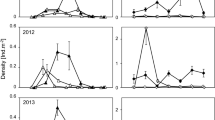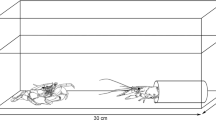Abstract
The coldwater crayfish Orconectes eupunctus is endemic to the Spring and Eleven Point Rivers of Arkansas and Missouri, and appears to have been displaced from a portion of its range by the recently introduced ringed crayfish Orconectes neglectus. We examined competition among juveniles as a potential mechanism for this crayfish species displacement through laboratory and field experiments. Orconectes eupunctus juveniles survived and grew in stream cages in their former range, implicating biotic interactions rather than habitat degradation in the displacement. Laboratory experiments revealed O. neglectus juveniles were dominant in the presence of limited food, whereas size rather than species determined occupancy of limited shelter. In a field competition experiment using stream cages, O. neglectus juveniles did not inhibit growth or reduce survival of O. eupunctus juveniles. Consequently, laboratory evidence of O. neglectus dominance did not correspond with competition under field conditions. Combined with previous studies examining the effects of O. neglectus on O. eupunctus, these results suggest that competition may not be a factor in this crayfish species displacement. Alternate mechanisms for the apparent displacement of O. eupunctus by O. neglectus, such as differential predation or reproductive interference, should be investigated.



Similar content being viewed by others
References
Bergman DA, Moore PA (2003) Field observations of intraspecific agonistic behavior of two crayfish species, Orconectes rusticus and Orconectes virilis, in different habitat. Biol Bull 205:26–35. doi:10.2307/1543442
Bergman DA, Moore PA (2005) Prolonged exposure to social odors alters subsequent social interactions in crayfish (Orconectes rusticus). Anim Behav 70:311–318. doi:10.1016/j.anbehav.2004.10.026
Berrill M, Arsenault M (1984) The breeding behavior of a north temperate orconectid crayfish, Orconectes rusticus. Anim Behav 32:333–339. doi:10.1016/S0003-3472(84)80265-1
Bouchard RW (1977) Distribution, ecology, and systematic status of five poorly known western North American crayfish (Decapoda: Astacidae and Cambaridae). Freshwat Crayfish 3:409–423
Bovbjerg RV (1953) Dominance order in the crayfish Orconectes virilis (Hagen). Physiol Zool 26:173–178
Butler MJ, Stein RA (1985) An analysis of the mechanisms governing species replacements in crayfish. Oecologia 66:168–177
Capelli GM, Munjal BL (1982) Aggressive interactions and resource competition in relation to species displacement among crayfish of the genus Orconectes. J Crustac Biol 2(4):486–492. doi:10.2307/1548090
Daniels RA, Murphy DC, Klemens MW (2001) Orconectes neglectus is established in the northeast. Northeastern Nat 8(1):93–100
Daws AG, Grills G, Konzen K, Moore PA (2002) Previous experiences alter the outcome of aggressive interactions between males in the crayfish, Procambarus clarkii. Mar Freshwat Behav Physiol 35(3):139–148. doi:10.1080/1023624021000014725
Englund G, Olsson T (1996) Treatment effects in a stream fish enclosure experiment: influence of predation rate and prey movement. Oikos 77:519–528. doi:10.2307/3545941
Evans-White MA, Dodds WK, Whiles MR (2003) Ecosystem significance of crayfishes and stonerollers in a prairie stream: functional differences between co-occurring omnivores. J N Am Benthol Soc 22(3):423–441. doi:10.2307/1468272
Figler MH, Cheverton HM, Blank GS (1999) Shelter competition in juvenile red swamp crayfish (Procambarus clarkii): the influences of sex differences, relative size, and prior residence. Aquaculture 178:63–75. doi:10.1016/S0044-8486(99)00114-3
Flinders CA, Magoulick DD (2003) Effects of stream permanence on crayfish community structure. Am Midl Nat 149:134–147. doi:10.1674/0003-0031(2003)149[0134:EOSPOC]2.0.CO;2
Flinders CA, Magoulick DD (2005) Distribution, habitat use and life history of stream-dwelling crayfish in the Spring River drainage of Arkansas and Missouri with a focus on the imperiled Mammoth Spring crayfish (Orconectes marchandi). Am Midl Nat 154:358–374. doi:10.1674/0003-0031(2005)154[0358:DHUALH]2.0.CO;2
Fortino K, Creed R (2007) Abiotic factors, competition or predation: what determines the distribution of young crayfish in a watershed? Hydrobiologia 575(1):301–314. doi:10.1007/s10750-006-0378-7
Frutiger A, Buergisser GM (2002) Life history variability of a grazing stream insect (Liponeura cinerascens minor; Diptera:Blephariceridae). Freshw Biol 47(9):1618–1632. doi:10.1046/j.1365-2427.2002.00899.x
Garvey JE, Stein RA, Thomas HM (1994) Assessing how fish predation and interspecific prey competition influence a crayfish assemblage. Ecology 75(2):532–547. doi:10.2307/1939556
Gherardi F, Cioni A (2004) Agonism and interference competition in freshwater decapods. Behavior 141:1297–1324. doi:10.1163/1568539042729702
Gherardi F, Daniels WH (2004) Agonism and shelter competition between invasive and indigenous crayfish species. Can J Zool 82:1923–1932. doi:10.1139/z04-185
Gurevitch J, Morrow LL, Wallace A, Walsh JS (1992) A meta-analysis of competition in field experiments. Am Nat 140:539–572. doi:10.1086/285428
Hanson JM, Chambers PA, Prepas EE (1990) Selective foraging by the crayfish Orconectes virilis and its impact on macroinvertebrates. Freshw Biol 24(1):69–80. doi:10.1111/j.1365-2427.1990.tb00308.x
Hill AM, Lodge DM (1999) Replacement of resident crayfishes by an exotic crayfish: the roles of competition and predation. Ecol Appl 9(2):678–690. doi:10.1890/1051-0761(1999)009[0678:RORCBA]2.0.CO;2
Keller TA, Tomba AM, Moore PA (2001) Orientation in complex chemical landscapes: spatial arrangement of chemical sources influences crayfish food-finding efficiency in artificial streams. Limnol Oceanogr 46(2):238–247
Larson ER (2007) Effects of an introduced crayfish on a native crayfish in an Ozark stream: the role of life history and juvenile competition. Thesis, University of Arkansas
Lodge DM, Taylor CA, Holdich DM, Skurdal J (2000) Nonindigenous crayfish threaten North American freshwater biodiversity: lessons from Europe. Fisheries 25(8):7–19. doi:10.1577/1548-8446(2000) 025 ≤ 0007:NCTNAF ≥ 2.0.CO;2
Magoulick DD, DiStefano RJ (2007) Invasive crayfish Orconectes neglectus threatens native crayfishes in the Spring River drainage of Arkansas and Missouri. Southeast Nat 6(1):141–150. doi:10.1656/1528-7092(2007)6[141:ICONTN]2.0.CO;2
Mazlum Y, Eversole AG (2005) Growth and survival of Procambarus acutus acutus (Girard, 1852) and P. clarkii (Girard, 1852) in competitive settings. Aquacult Res 36:537–545. doi:10.1111/j.1365-2109.2005.01250.x
Missouri Natural Heritage Program (2008) Missouri species and communities of conservation concern checklist. Jefferson City, MO
Mason JC (1970) Maternal-offspring behavior of the crayfish, Pacifastacus towbridgi (Stimpson). Am Midl Nat 84(2):463–473. doi:10.2307/2423861
Momot WT (1995) Redefining the role of crayfish in aquatic ecosystems. Rev Fish Sci 3(1):33–63
Moore PA, Grills JL (1999) Chemical orientation to food by the crayfish Orconectes rusticus: influence of hydrodynamics. Anim Behav 58:953–963. doi:10.1006/anbe.1999.1230
Morin A, Dumont P (1994) A simple model to estimate growth rate of lotic insect larvae and its value for estimating population and community production. J N Am Benthol Soc 13(3):357–367. doi:10.2307/1467365
Muck JA, Rabeni CF, DiStefano RJ (2001) Reproductive biology of the crayfish Orconectes luteus (Creaser) in a Missouri stream. Am Midl Nat 147:338–351. doi:10.1674/0003-0031(2002)147[0338:RBOTCO]2.0.CO;2
Nyström P (1994) Survival of juvenile signal crayfish (Pacifastacus leniusculus) in relation to light intensity and density. Nord J Freshw Res 69:162–166
Paglianti A, Gherardi F (2004) Combined effects of temperature and diet on growth and survival of young-of-year crayfish: a comparison between indigenous and invasive species. J Crustac Biol 24(1):140–148. doi:10.1651/C-2374
Perry WL, Felder JL, Lodge DM (2001) Implications of hybridization between introduced and resident Orconectes crayfishes. Conserv Biol 15(6):1656–1666. doi:10.1046/j.1523-1739.2001.00019.x
Pflieger WL (1996) The crayfishes of Missouri. Missouri Department of Conservation, Jefferson City, MO
Rabalais MR, Magoulick DD (2006a) Influence of an invasive crayfish species on diurnal habitat use and selection by a native crayfish species in an Ozark stream. Am Midl Nat 155:295–306. doi:10.1674/0003-0031(2006)155[295:IOAICS]2.0.CO;2
Rabalais MR, Magoulick DD (2006b) Is competition with the invasive crayfish Orconectes neglectus chaenodactylus responsible for the displacement of the native crayfish Orconectes eupunctus?. Biol Invasions 8:1039–1048. doi:10.1007/s10530-005-4649-4
Rabeni CF (1985) Resource partitioning by stream-dwelling crayfish: the influence of body size. Am Midl Nat 113:20–29. doi:10.2307/2425344
Rahm EJ, Griffith SA, Noltie DB, DiStefano RJ (2005) Laboratory agonistic interactions demonstrate failure of an introduced crayfish to dominate two imperiled endemic crayfishes. Crustaceana 78(4):437–456. doi:10.1163/1568540054473585
Ranta E, Lindström K (1993) Body size and shelter possession in mature signal crayfish, Pacifastacus leniusculus. Ann Zool Fenn 30:125–132
Söderbäck B (1991) Interspecific dominance relationship and aggressive interactions in the freshwater crayfishes Astacus astacus (L.) and Pacifastacus leniusculus (Dana). Can J Zool 69:1321–1325
Söderbäck B (1994) Interactions among juveniles of two native crayfish species and a predatory fish. Oecologia 100(3):229–235. doi:10.1007/BF00316949
Taylor CA, Schuster GA, Cooper JE, DiStefano RJ, Eversole AG, Hamr P et al (2007) A reassessment of the conservation status of crayfishes in the United States and Canada after 10+ years of increased awareness. Fisheries 32(8):372–389
Usio N, Konishi M, Nakano S (2001) Species displacement between an introduced and a ‘vulnerable’ crayfish: the role of aggressive interactions and shelter competition. Biol Invasions 3:179–185. doi:10.1023/A:1014573915464
U.S. Department of the Interior Fish, Wildlife Service (1986) Endangered and threatened wildlife and plants; determination of endangered status for the Nashville crayfish Orconectes shoupi. Fed Regist 51:34410–34412
Vorburger C, Ribi G (1999) Aggression and competition for shelter between a native and an introduced crayfish in Europe. Freshw Biol 42:111–119. doi:10.1046/j.1365-2427.1999.00465.x
Whitledge GW, Rabeni CF (1997) Energy sources and ecological roles of crayfishes in an Ozark stream: insights from stable isotopes and gut content analysis. Can J Fish Aquat Sci 54(11):2555–2563. doi:10.1139/cjfas-54-11-2555
Williams AB (1954) Speciation and distribution of the crayfishes of the Ozark plateaus and Ouchita provinces. Univ Kans Sci Bull 36(2):805–916
Willman EJ, Hill AM, Lodge DM (1994) Response of three crayfish congeners (Orconectes spp.) to odors of fish carrion and live predatory fish. Am Midl Nat 132(1):44–51. doi:10.2307/2426199
Acknowledgements
This research was supported by a grant from the Arkansas Game and Fish Commission. Comments from A.V. Brown, R.J. DiStefano, G.R. Huxel, D.M. Lodge and two anonymous reviewers improved the quality of this manuscript. We thank all landowners who provided river access during this study. The Arkansas Cooperative Fish and Wildlife Research Unit is supported by the Arkansas Game and Fish Commission, University of Arkansas, U.S. Geological Survey, and the Wildlife Management Institute.
Author information
Authors and Affiliations
Corresponding author
Rights and permissions
About this article
Cite this article
Larson, E.R., Magoulick, D.D. Does juvenile competition explain displacement of a native crayfish by an introduced crayfish?. Biol Invasions 11, 725–735 (2009). https://doi.org/10.1007/s10530-008-9286-2
Received:
Accepted:
Published:
Issue Date:
DOI: https://doi.org/10.1007/s10530-008-9286-2




